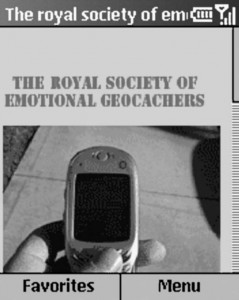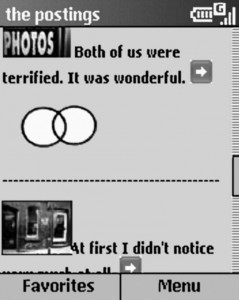Chris Caines is a Sydney based artist who has been working across the media of film, video, online media and public art for the past 15 years. His recent work Go This way explores some of the new artistic possibilities presented by GPS (Global Positioning System) and mobile communication technologies to create public art works where the action takes place across online (virtual) and real (physical) spaces.

Go This Way (screen grab), courtesy Chris Caines
Go This Way merges online hypertext writing with real physical locations. The work incorporates a series of linked hypertext fictional narratives designed to be experienced on foot, mobile phone in hand in the Melbourne CBD. The audience members become networked flaneurs, wandering the city pulling narratives out of the ether with their mobile phone or PDA. The piece was developed for the exhibition Networked, curated by Melinda Rackham as part of the Australia Culture Now 2004 exhibition at Australian Centre for the Moving Image in Melbourne (8 June – 12 September 2004).
Caines’ work draws on the popular phenomenon of geocaching which typically involves adventure game scenarios where GPS (Global Positioning System) coordinates and other clues are used to locate objects in the real world. In “Go This Way”, the cache the audience finds is an intimate, personal story or experience that is connected with each location. The audience navigates via maps, addresses and pictures found on the “Go This Way” website and the locations in downtown Melbourne. The physical sites include stickers that contain the URLs of the website stories as well as identifying icons that Caines adapted from the “hobo language” developed by itinerant workers in the US during the 30s depression.
Caines comments, “the project uses the convention of a fictional “society” that in the manner of GPS mad geocachers annotates actual spaces with stories of peak emotional experiences that occurred for them at these sites. There are six of these memories posted in the work. I’ve tried to use the confessional writing style and voice conventions of blog posts and the iconography of the site echoes the hobo language of pictorial signs developed during the 1930s depression so those “on the road” could communicate with each other about opportunities or dangers in certain locations.”
The hypertext narratives in Go This Way include the death of a homeless person Terry (“six foot three, wild unruly halo of an afro, ratty black leather coat dragging the ground around his bare feet”); a public sex encounter in a B&W photo booth; a marriage disintegrating over a public payphone and a drug taking experience in Misty Bar.

Go This Way (screen grab), courtesy Chris Caines
Comments Melinda Rackham, “it is great to see artists working with blended realities. Chris playfully intertwines fictive but situated narratives, so that you are never sure if you are stumbling into someone’s private life or not. Combined with delivery on the intimate mobile screen, it gives the work a delicious sense of voyeurism”.
As well as navigating the physical locations and reading their associated stories, audience members can also upload their own responses to the narratives and read the comments of other contributors on the website (http://madeupstuff.com/go).
The characters in the stories are based on people Caines photographed and had conversations with in buses and trams during a series of research trips to Melbourne, “I didn’t really know Melbourne that well before I started this process and writing the characters became like a portrait of the part of town I got to know.”
The layering of personal stories over the physical street scape of Melbourne creates a hyperlinked public artwork which activates the city’s hidden memories. “The general effect the piece goes for is the immersive resonance I think you can get reading a story about someone’s experience whilst inhabiting the exact location where that experience occurred.”
Caines’ works can be broadly situated within the context of other works such as UK based performance group Blast Theory’s I Like Frank (performed earlier this year in Adelaide) and 34 North 118 West created by a trio of Los Angeles artists which uses GPS locations to trigger audio accounts of the city’s history. These works are part of the emerging genres of ‘mixed reality’ and ‘locative media’ work which creatively blend online and physical spaces.
Caines is currently experimenting with a video version of Go This Way based in the Sydney CBD and is planning to create a suburb wide piece in Western Sydney where audience members will be able to upload photos, text and video.
Kathy Cleland
Kathy Cleland is a freelance writer and curator. She lectures in the Arts Informatics Program at the University of Sydney.
Read More
http://www.arts.usyd.edu.au/digital_cultures/
www.34n118w.net
 This work is licensed under a Creative Commons Attribution-NonCommercial-ShareAlike 3.0 Australia.
This work is licensed under a Creative Commons Attribution-NonCommercial-ShareAlike 3.0 Australia.






